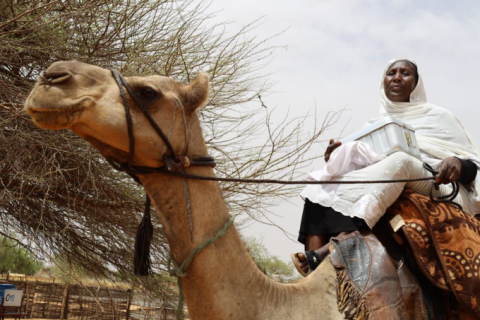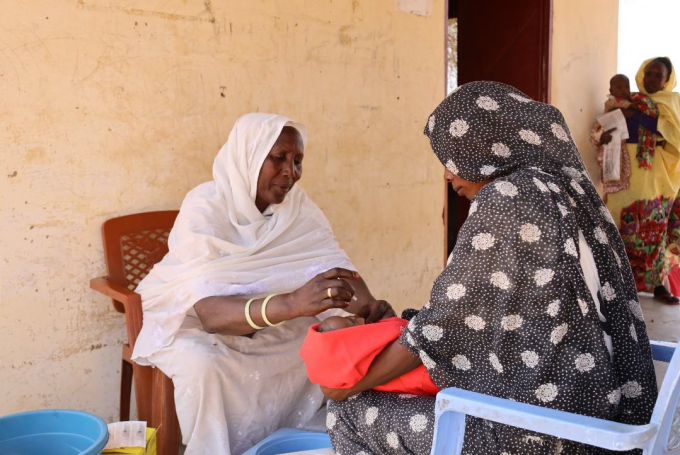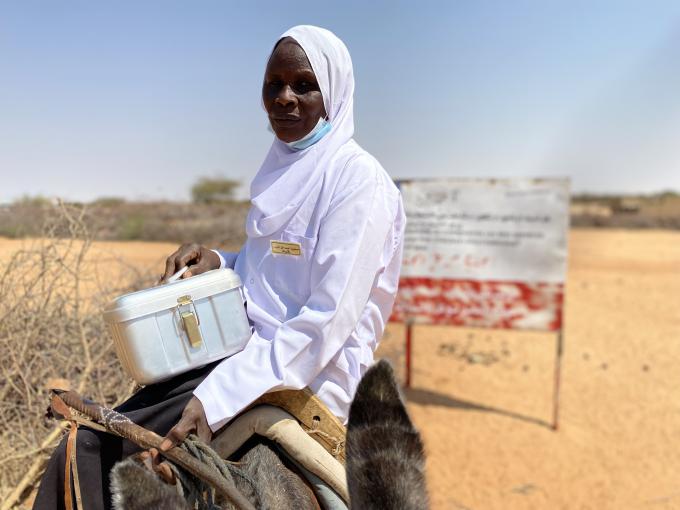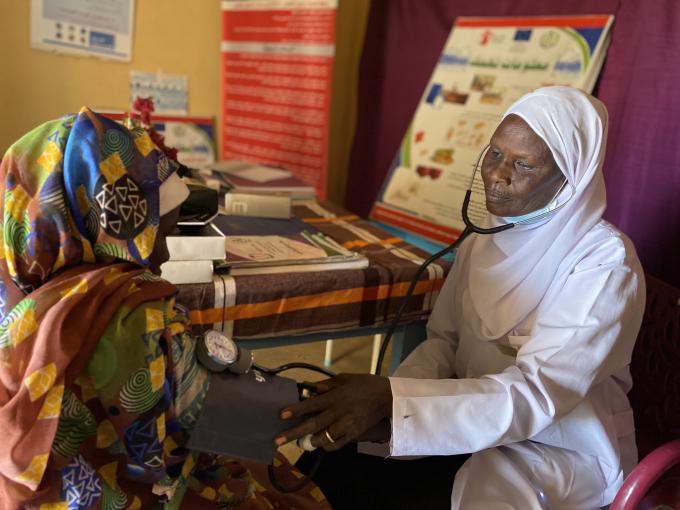قابلات كالاميندو: في مهمة لإنقاذ النساء والأطفال | Kalamendo midwives: on a mission to save women and children one delivery at a time

يمكن أن تكون حالات الحمل والولادة معقدة للغاية - فعادة ما تتعرض النساء في المناطق النائية مثل كالاميندو في شمال دارفور لخطر فقدان حياتهن أو حياة أطفالهن.
مع وجود القابلات ، مثل فاطمة ومستورة ، اللواتي لا يتمتعن بالمهارة والتدريب فحسب، ولكنهن شغوفات بمهمتهن - يقل هذا الخطر بشكل كبير.
قصة فاطمة:
في شبابها، أرادت فاطمة أن تصبح قابلة لمساعدة النساء في قريتها على التغلب على المخاطر أثناء الولادة.
"في قريتي ماتت عدة نساء أثناء الولادة، في بعض الحالات بسبب ممارسات الولادة التقليدية. أردت تغيير ذلك ومساعدة النساء على الولادة بطريقة آمنة ".
في التسعينيات قررت فاطمة، وهي أم لطفلين، مغادرة قريتها للدراسة في مدرسة القبالة في الفاشر، عاصمة ولاية شمال دارفور. بعد التخرج، اكتسبت المزيد من الخبرة في مستشفى الفاشر - أحد المرافق الصحية القليلة جدًا في الولاية. أخيرًا، بصفتها قابلة متمرسة، عادت إلى قريتها الأصلية.
تقع قصة جمت على بعد حوالي 3 ساعات بالسيارة غربًا من عاصمة الولاية في منطقة قاحلة جدًا في السودان. المياه شحيحة ويكافح الناس لتغطية نفقاتهم. في المنطقة، كما هو الحال في معظم أنحاء السودان، تركت عقود من نقص الاستثمار في البنية التحتية الصحية المرافق الطبية في حالة مقفرة. الأدوية والمعدات غير كافية، والمباني مهجورة، ومعظم الموظفين غير مدربين بصورة جيدة.
تتذكر فاطمة كيف كان الوضع قبل أن تبدأ منظمة رعاية الطفولة العمليات في المنطقة:
"لم تكن هناك مرافق صحية عاملة في الجوار. كنت أجلس في المنزل وكان النساء يتصلن بي عندما يقتربن من الولادة. في حالة حدوث مضاعفات خطيرة، كنت أحاول العثور على سيارة مستأجرة والسفر مع والدتي طوال الطريق إلى مستشفى الفاشر، على أمل أن تخضعن لعملية جراحية. ومع ذلك، لا يستطيع سكان القرية في كثير من الأحيان تحمل تكاليف استئجار سيارة أو رسوم المستشفى ".
تواصل فاطمة، وهي نفسها اليوم أم لثمانية أطفال، شرح كيف أدى مشروع منظمة رعاية الطفولة، الممول من الاتحاد الأوروبي، إلى تحسين الوضع في قرية قصات جامات والقرى المجاورة:
في عام 2015، بدأت منظمةرعاية الطفولة العمل هنا. قاموا بتجديد المرافق وتدريب الموظفين وتجهيزهم وبناء غرفة للولادات وتقديم برنامج التغذية. كما تلقينا مجموعات توصيل، مثل القفازات، والصوف القطني، وشفرات الحلاقة، والأغطية البلاستيكية، وغيرها من المواد الأساسية، وتم تدريبنا على قضايا النظافة. كان الدعم مطلوبًا، حيث تواجه النساء هنا الكثير من التهديدات لصحتهن ".
معدلات سوء التغذية في شمال دارفور مرتفعة للغاية. المنطقة رملية وساخنة، ونتيجة لتغير المناخ، انخفض هطول الأمطار بشكل أكبر. ونتيجة لذلك، أثر ضعف المحاصيل بشدة على السكان في السنوات الأخيرة.
علاوة على ذلك، يعاني السودان من أزمة اقتصادية مع ارتفاع معدلات التضخم. منذ عام 2020، زادت تكاليف متوسط سلة الغذاء سبعة أضعاف. ترى العديد من العائلات نفسها مضطرة لتقليل عدد الوجبات وتناول طعام أقل تنوعًا. حذر برنامج الغذاء العالمي التابع للأمم المتحدة بالفعل من أن 40٪ من سكان السودان سيتعرضون لخطر الجوع في عام 2022. شمال دارفور هي واحدة من أكثر الولايات تضررًا.بسبب هذه الظروف، تراقب فاطمة بعناية الصحة العامة للأم أثناء الحمل:
"تأتي النساء لرؤيتي كل أربعة أسابيع خلال الأشهر الثمانية الأولى. في الشهر الماضي، التقيت بهن على أساس أسبوعي. أبدأ دائمًا بإجراء فحص طبي عام. إذا كنت قلقة بشأن حالتهن الصحية أو التغذوية، فإني أحيلهن على الفور إلى طبيب في المركز الصحي، حيث يتلقين الدعم اللازم. عندما يحين وقت الولادة، سأمتطي جملي بأسرع ما يمكن لمساعدتهم ".

نظرًا لأن النساء في قرية قصة جمت والقرى المجاورة يمكنهن الآن الحصول على دعم أكثر وجودة أفضل أثناء الحمل، لذلك انخفضت معدلات الوفيات أثناء الولادة بشكل ملحوظ وفقًا لملاحظة فاطمة: "يموت عدد أقل من النساء الآن، بسبب الدعم الذي يمكن أن يحصلن عليه من الصحة. المركز، من نفسي ومن زملائي. أنا ممتنة للغاية لذلك. حتى ابنتي الكبرى لديها الدافع لممارسة مهنة مماثلة. لقد غادرت مؤخرًا إلى الفاشر للدراسة في مدرسة التمريض ".
قصة مستورة:
أما مستورة، بينما يرى الكثيرون أن مشهد مستورة وهي تسافر على ظهور الحمير عبر سهول كالاميندو لتوليد الأطفال حديثي الولادة هو مشهد بطولي للغاية، هذه وظيفتها اليومية.
تم تدريب مستورة، وهي أول قابلة في منطقتها، في مدرسة القابلات في الفاشر وتمارس القبالة منذ ما يقرب من 40 عامًا. قالت لنا: "أصبحت قابلة لإنقاذ النساء أثناء الولادة".
تعمل في المنشأة الصحية الحالية في قرية أم كادويا الغربية - بدعم من منظمة إنقاذ الطفولة وبتمويل من العمليات الإنسانية للاتحاد الأوروبي - منذ عام 2016. في الأيام العادية، يتم تقديم علاجها بشكل أساسي للنساء الحوامل - وفي بعض الأحيان المرضعات. وذلك من خلال المتابعات خاصة لمن يواجهن صعوبات أثناء الحمل مثل فقر الدم أو وضعيات غير طبيعية للجنين. من الاستشارات الأولى، تفحص التغذية، وتحسن الحالة بالأطعمة المناسبة والمتوفرة، مثل التمر والعدس والحليب.

ثم تأتي الولادة - تقول مستورة إنها غالبًا ما تسافر إلى القرى المجاورة، لمسافة تصل إلى ساعة ونصف على ظهر الحمار لتوليد الأمهات. "غالبًا ما أضطر إلى السفر ليلًا لأداء الولادات في المنزل. في بعض الأحيان، هناك حالات خطيرة. يجب أن أصلها بسرعة لإنقاذ حياة الأمهات. إحدى الحالات التي أتذكرها في حالة الولادة لأول مرة أصيبت بتسمم الحمل. وسرعان ما رتبنا سيارة إسعاف لنقلها إلى الفاشر. كان انتظار السيارة من أصعب الأوقات. فعلت كل ما في وسعي لاحتواء الموقف قبل وصول السيارة ونقلتها إلى مستشفى الفاشر. الحمد لله ، لقد نجت هي والطفل ".
بما في ذلك توفير الإشراف والرعاية والمشورة اللازمة للمرأة أثناء الحمل والولادة وفترة ما بعد الولادة ، وتدريبهن على إجراء الولادات بأنفسهن و رعاية الأطفال حديثي الولادة. القابلات المدعومات من هذا المشروع مسؤولات أيضًا عن تدريب القابلات الأخريات ، لإنشاء شبكة من العاملين الصحيين المجتمعيين الذين يمكنهم استيعاب عدد متابعات الحمل.

بينما في الماضي ، أدى هذا النوع من التدخل إلى انخفاض كبير في معدلات وفيات الأمهات والرضع أثناء الولادة. تضيف مستورة قائلة: "توفر المرافق الصحية التابعة لمنظمة" أنقذوا الأطفال "عددًا من الموارد ، مثل مجموعات الولادة ، والتعليم حول الولادة ومخاطرها". "نزود النساء بحديد فيفول وحمض الفوليك ، وتكلفة إحالة الحالات إلى الفاشر ، بالإضافة إلى تغذية الأطفال."
القابلات ذوات الخبرة مثل مستورة يتفهمن حجم المخاطر التي تهدد الحياة والتي تأتي مع الحمل والولادة ؛ تطلعاتها إلى النساء والأطفال حديثي الولادة أكبر: "أحلم أن يكون لدى المركز الصحي غرفة ولادة متكاملة لإجراء جميع الولادات دون الحاجة إلى الرجوع إلى الفاشر".
دعم الاتحاد الأوروبي للمساعدات الإنسانية مشروع واسع النطاق للصحة والتغذية وتوليد الدخل، ويدعم 28 مرفقًا صحيًا، مثل ذلك الموجود في قصة جمت، في أربع ولايات سودانية.
يهدف المشروع إلى المساهمة في الحد من الاعتلال والوفيات والعجز الدائم المتعلق بالصحة والتغذية بالإضافة إلى التخفيف من آثار COVID-19 لأكثر من 400,000 شخص.
تدعم برامج إنقاذ الطفولة الصحية في جميع أنحاء السودان أكثر من 165 منشأة طبية.
Pregnancies and childbirths can be extremely complicated - women in remote areas like Kalamendo, in North Darfur, usually are at risk of losing their or their children's lives.
With midwives, like Fatima and Mastoura, who are not only skilled and trained, but passionate about their mission - this risk decreases significantly.
Fatima’s story:
Already as a young woman, Fatima wanted to become a midwife to help women in her village defeat the risks during childbirth.
“In my village several women died during the delivery, in some cases caused by the traditional birth practices. I thought, that I want to change that and help women deliver in a safe way.”
In the 1990s, already a mother of two children, Fatima decided to leave her village to study at the school of midwifery in El Fasher, North Darfur’s state capital. After graduation, she went on to gain more experience in El Fasher Hospital – one of the very few health facilities in the state. Finally, as an experienced midwife, she returned to her home village.
Qissat Gamat lies about 3 hours drive west from the state capital in a very arid region of Sudan. Water is scarce and people struggle to make ends meet. In the area, as in much of the rest of Sudan, decades of lack of investment into health infrastructure have left medical facilities in a desolate state. Medicines and equipment are insufficient, buildings derelict, and most staff is not well trained.
Fatima remembers the time before Save the Children took up operations in the area:
“There were no functioning health facilities nearby. I used to sit at home and women called me when they approach delivery. In case of serious complications, I would try to find a rental car and travel with the mother all the way to El Fasher hospital, hoping that she would be operated. Yet, people from the village can often neither afford renting a car nor the hospital fees.”
Fatima, today herself a mother of eight children, continues to explain how Save the Children’s project, funded by the European Union, improved the situation in Qissat Gamat and the surrounding villages:
“In 2015, Save the Children started working here. They renovated the facilities, trained and equipped staff, built a room for deliveries and introduced a nutrition programme. We also received delivery kits, such as gloves, cotton wool, razor blades, plastic sheets, and other key items and were trained on hygiene issues. The support was needed, as women here face a lot of threats to their health.”
In North Darfur, malnutrition rates are very high. The area is sandy and hot and, driven by climate change, rainfalls have been reduced further. As a result, poor harvests impacted severely on the population in the last years. Further, Sudan is experiencing an economic crisis with soaring inflation. Since 2020, the costs of an average food basket has increased seven-fold. Many families see themselves forced to reduce the number of meals and eat less varied food. The UN’s World Food Programme has already warned that 40% of the Sudanese population will be at risk of hunger in 2022. North Darfur is one of the most affected states.
Due to these conditions, Fatima is monitoring carefully the overall health of the mothers during the pregnancy:
“Women come to see me every four weeks during the first eight months. In the last month, I meet them on a weekly basis. I always start with a general health check-up. If I am concerned about their health or nutrition status, I refer them immediately to a doctor in the health centre, where they receive the necessary support. When the time for delivery comes, I will ride my camel as fast as possible to assist them.”
As women in Qissat Gamat and the surrounding villages can now access more and better quality support during the pregnancies, mortality rates during deliveries have notably decreased according to Fatima’s observation: “Less women are dying now, because of the support they can receive from the health centre, from myself and my colleagues. I am so grateful for that. Even my eldest daughter is motivated to pursue a similar profession. She recently left to El Fasher to study at the nursing school.”
Mastoura’s story:
While to many, the sight of Mastoura traveling by donkey across the plains of Kalamendo to deliver newborns is quite heroic, to her, it is the norm.
The first midwife in her region, Mastoura was trained at the School of Midwives in El Fasher and has been practicing midwifery for almost 40 years. “I became a midwife to save women during childbirth,” she told us.
She has been working in the current health facility in Um Kadoya West Village since 2016. On normal days, her treatment is mainly offered to pregnant – and at times, lactating – women, through follow-ups, especially those who are having difficulties during their pregnancy, such as anemia or abnormal fetus positions. From the first consultations, she examines nutrition, and sensitizes the case to the appropriate and available foods, such as dates, lentils, and milk.
Then comes delivery – Mastoura says she often travels to neighboring villages, as far as an hour and a half away by donkey to deliver newborns. “I often have to travel at night to perform home births. Sometimes, there are dangerous cases. I must respond quickly to save their lives.” she states. “One of the cases that I remember in the case of a first-time delivery. She got an eclampsia injury during birth. We quickly arranged for an ambulance vehicle to take her to El Fasher. Waiting for the vehicle was one of the hardest times, though. I did everything possible to contain the situation before the vehicle arrived her, taking her to El Fasher Hospital. Thank God, she and the child were both saved.”
At Save the Children, Child Protection is prioritized. The first way to protect a child is to save their lives during their birth. The health-focused project in the area focuses on primary healthcare consultations, with reproductive health as a priority; this includes midwives, like Mastoura, being further trained in providing life-saving obstetric care, including in giving the necessary supervision, care, and advice to women during pregnancy, childbirth and the postpartum period, and trained to conduct deliveries on their own and to care for newborns. Midwives supported by this project are also responsible for training other midwives, to create a network of community health workers that can accommodate the number of pregnancy follow-ups.
While in the past, this type of intervention has greatly reduced rates of maternal and infant mortality during childbirth. “Save the Children’s health facilities provide a number of resources, such as delivery kits, education about delivery and its risks,” adds Mastoura. “We provide women with Fefol Iron and Folic Acid, and the cost of referral cases to El Fasher, as well as nutrition for the children.”
Experienced midwives like Mastoura understand the magnitude of life-threatening risks that come with pregnancies and deliveries; her aspirations for women and newborns are even bigger: “I dream that the health center has an integrated delivery room to perform all deliveries without the need to refer to El Fasher.”
The European Union health, nutrition and income-generating large-scale project, supports 28 health facilities, such as the one in Qissat Gamat and Um Kadoya West, across four Sudanese states.
The project’s goal is to contribute to reducing health and nutrition-related morbidity, mortality and permanent disability as well as mitigating the effects of COVID-19 for more than 400.000 people.
Across Sudan Save the Children’s health programs support more than 165 medical facilities.
 Sudan
Sudan